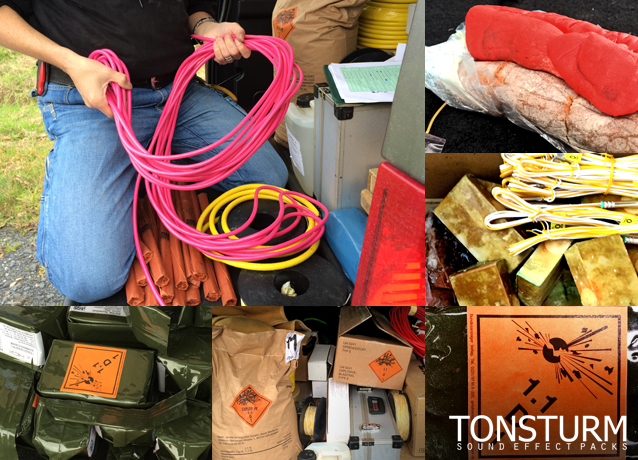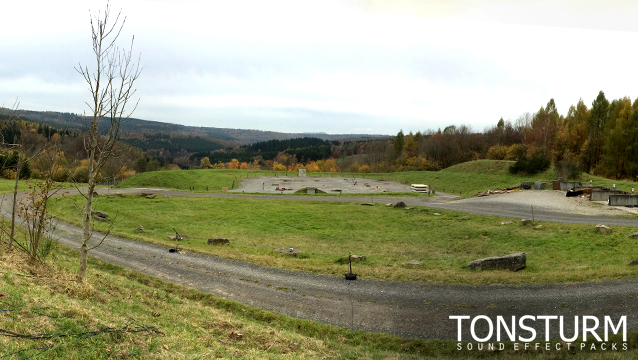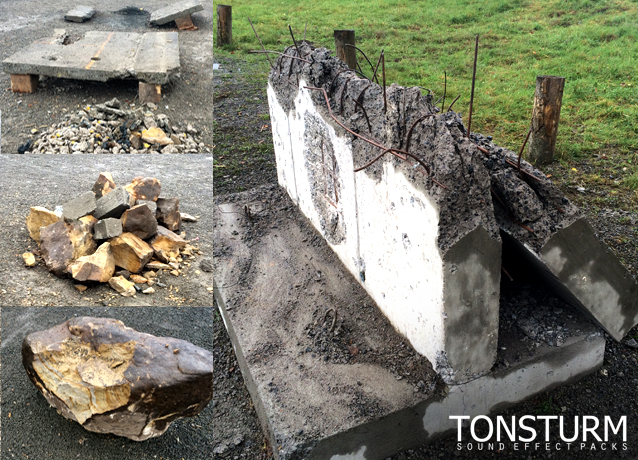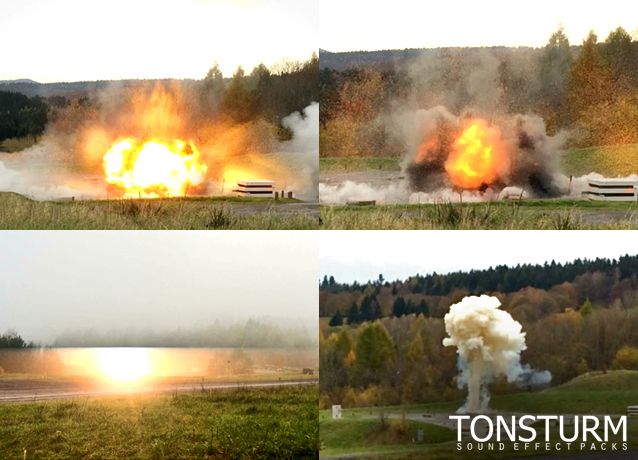Guest contribution by the fine folks at TONSTURM
As the theme of this month is destruction we are really happy to be invited on Designing Sound to share our stories about the production and creation of our latest sound effect library:
TONSTURM | Massive Explosions:
RESEARCH:
An essential part of creating TONSTURM libraries is an in depth research phase. Explosion sfx is something we have in our heads probably since we recorded our very first library back in 2010. In 2011 we did some test recordings at a blaster training school in eastern Germany. The recording conditions at that particular training area were not good enough to record for a library project, but it was a great experience and taught us how complex and challenging it would be to create an explosion library.
Up to now we don´t know any explosion effect library that features multi-channel recorded and mastered explosion sound effects and which offers you each explosion in different perspectives, microphone characteristics and channel formats. As the title of the library says, it was also our goal to record real massive explosions that we could not find elsewhere.
So we investigated into this topic frequently and talked to experts in this field. We are very thankful for all the great advice we got from Charles Maynes, who is the master when it comes to explosion and gun effect recordings. We highly recommend reading all the articles he has published on Designing Sound!
After a lot of investigation we finally got introduced to THE blaster expert here in Germany: Werner Meyerl. He is highly experienced in civil and military blasting operations, guns and pyrotechnics. We presented him our list of things we would wish to record and what recording conditions we would need. Because of the high amounts of explosives we had in mind it soon became clear, that we could not realize such a huge operation in any civil environment. Luckily he had great connections, and we were finally able to partner up with the German military!
PREPRODUCTION:
Besides the initial test recordings we gathered all information we could get about existing experiences on recording explosion effects: we listened to existing libraries and read countless articles on websites (Designing Sound!!). One important part was to learn about the detonation velocities of the various kinds of explosives and that different velocities will also sound different.
Together with Werner we finally came up with a long wish list containing the different kind of explosive material we wanted to record. Our goal was to come up with a great sounding variety of explosives and combinations. We also included stepped explosions as a nice extra. The final list features: TNT, PETN, ANFO, RDX, Semtex, Black Powder, Flash Powder, Det Cord, Dynamite, Gas Cartridges, Isopropanol, an Anti-Tank Mine, and more…
THE RECORDING SETUP:
Although we were prepared that it would cost a small fortune to realize explosion recordings of this scale, we got a bit of a shock when we saw the final cost calculation. Once we decided to go full risk, we made sure that we were fully armed on the recording side as well. We planned to record to as many channels as we could deal with. Eventually we ended up recording 19 channels maximum and took a carefully selected collection of microphones to the blasting stage.
MICROPHONES AND PLACEMENT:
Long distance: (280 meters) we used a pair of Sennheiser 8040s and 8020s wide spaced.
Mid distance A: (150 meters) we placed our wide spaced surround array equipped with five Sennheiser MKH 8020 omni microphones. Listening to these 5.0 files on a multi-channel setup is just mesmerizing.
Mid distance B: (80 – 100 meters) we placed a LCR rig consisting of 2 x MKH 8040 and one MKH 8050 for the center. These 3.0 Channel files sound very fat and fill the full L,C,R front. At this distance we also had two shot gun mics the Sennheiser MKH70 and the Neumann KMR82. We pointed them in every direction, but not to the explosion itself, to capture the beautiful reflections from the valley around.
Close distance: (50 meters) here we placed all our dynamic microphones: MD 421, MD 221 (Vintage), e602 (BD mic with huge bottom end), mpc66 boundary mic and SM75. The dynamic mics were dangerously close and captured the transients in a nice colored way. They simply delivered a lot of character. Our favorites here are the e602, as it features a huge bottom end and shapes the sound in a way that suits perfectly to explosion sfx. We are also fans of the boundary mic as it sounds real meaty and it self compresses in a way we really enjoy listening to.
For more experimental positions we repositioned the Sony D100 whenever we could. And we are always surprised how good this integrated recorder does sound!
Having all these channel and microphone choices at hand for designing the stereo combined versions was a sheer joy!
The single microphone channels:
The combined mastered versions:
THE BLASTING AREA:
The arrival to the military blasting area felt like in a movie. We had to cross several guarded areas and were not allowed to film or take photos. The place was everything you could wish for. It was huge and situated in a beautiful looking and sounding valley. It was early November, and the nature was pretty quiet. We booked the area for two full days and shared it with the military. So besides the massive amounts of explosives we brought with us we were also able to record detonations that were part of the military training. This was like winning the jackpot, as those guys really blew up some crazy stuff. This way we were able to record detonating explosives of multiple kilograms that were attached to a big steel bar, steel wired cement walls or inserted into a granite rock. Things you usually never get permission for. It is simply too dangerous, as the debris can have a speed up to 7500 meter per second!
During the detonating phases we had to stay at a bunker which was about 270 meters away, but most of the time we were allowed to stay outside nearby the bunker to experience the arriving shock wave massage our bodies.
The procedure began with planning a series of explosion shots which then had to be prepared and wired up by our blaster expert while we checked, repositioned and prepared our recording equipment. Finally each explosion could be ignited via radio transmission from a safe distance. The military used an air horn to communicate on the place (for example that the area is clean or that an explosion will be fired up next). After a series of explosions had been fired by us or the military, we carefully listened to the recorded files to decide whether we could improve the position of the microphones etc.
On the second day, we wanted to slim down the microphone arrays a little, as this was the day we were able to record more of the explosions planned by the military and we had to be more flexible for this. As already mentioned, this was the crazy and unpredictable stuff like an anti tank mine that shot through a 10 cm thick wall of steel.
EXPERIENCING MASSIVE EXPLOSIONS:
To experience an explosion of this size is pretty intense. After each day we had a big smile on our face, and felt like we had made a huge bungee jump or something. During the whole operation over 120kg of explosives were blown up. To hear, see and feel this raw massive energy is equally frightening and beautiful at the same time. First you see the explosion, then comes the shock wave, and about the same moment you hear the air ripping sound which is followed by a long growling tail. After these two days we are watching and hearing war movies with totally different ears and eyes. We believe for the next level of immersive audio someone should come up with a shock wave generator for cinema! :-)
We hope you enjoyed this little article about our latest TONSTURM | Massive Explosions effects library. Great sounding Explosion effects can be useful in many situations in sound design and we would like to end this with a few examples of what can be done with some simple but effective twists:
Pitched Down:
Because a lot of Sennheiser 8000 series extended frequency range microphones were part of the 96 kHz recording and mastering chain, you get really rewarding results when pitching the sound files down by an octave.
Convolution Example:
This is where it is getting interesting. Using the explosion effects for example with Altiverb as impulse response!
Reverse:
Simple but very effective for certain sound design applications. Especially if you think of the 5.0 surround recorded channels for example.
To celebrate this article we are giving away 1 copy of our TONSTURM | Massive Explosions – Multi Channel library. Enter the DesigningSound and TONSTURM giveaway and you could be the lucky winner!
For the chance to win, you need to do 2 things:
- Leave a comment at the bottom of this page where you describe a unique situation to use an explosion as a design element…not just to cover an actual explosion
- Post, tweet or share this article on Facebook and tag Designing Sound and TONSTURM.
We will contact the randomly selected winner via the post below, Facebook or Twitter in one week from today.
…Or you could get the TONSTURM Massive Explosions library here.
Prices:
Multichannel 96 kHz Version / Price: $249,00 US – Includes:
• 24 Bit 96 kHz / 60 Explosions / 656 Files / Up to 19 Channels per Explosion
• Combined Stereo version included
Combined Stereo 96 kHz Version / Price: $179 US – Includes:
• 24 Bit 96 kHz / 60 Explosions / 177 Files / 3 Stereo Files per Explosion





I recently used some generic explosion impact sounds as a low end sweetener for some slow-motion footsteps. Would be great to have more choices for explosion sounds. Excellent sounding library!
The library came out so well! a truly amazing resource for any sound folks….
gret work all around.
I knew that it’s hard to record stuff like this properly, but actually I never thought that it would need so much preproduction. Now it all seem obvious, but only after reading the whole thing through. Really nice work!
Love it! It’s amazing how much the valley itself lends such a specific character to the recordings.
Most recently, I used a reversed rattly explosion to craft a cool spaceship pass.
I love to use explosion sounds for low end transients to create magical sound effects. Recently I’ve been working on a game that uses time travel as one of it’s core mechanics. Used some filtered explosion sounds as the “punch” for when the player transitions back in time.
I am working now on a conceptual radio piece that is about the water. This work is contrasting our ignorance and ease of access, and the world where people struggle without water. I am using explosion elements in the opening, which is set up in the sky where we form a water drop. A place of great power. Mind you there is no VO!
Btw. Thank you for the great read! Good job!
Best wishes,
T.
Great work guys! I love watching your “behind the scenes” videos and this article is even better!
Something I like to do with explosions is use heavily automated spectral and temporal processing on them to create interesting flangey/phasey/musical hits that can then be used for a wide variety of applications. I have used this for bys, sci-fi guns, fantasy spells, vehicle backfires, etc. Great fun!
Thanks again!
Todd
For upgrading any impact or LFE-action i prefer lowpass-filtered explosions, whether they support an earthquake or the crash of a heavy everyday object. In general spectral segments of explosions greatly help sudden events that need strong attacks!
I often used explosions backward-forward in radio-promotion instead of deep swooshes – until i got myself the “Meltedsounds-Whoosh”-instrument.
You can do even drones from full range explosions: Long reverberation and fade-in is a good starting point, then let’s get creative or destructive with your more weird plugins ;-)
Recently i designed a object based interactive WW1 „radio-feature“ for tracked headphones – by adding 7 poorly matching stereo sources from different sources into 13.1-surround. It would have been much better and more easy to just choose some nice perspectives from one single original explosion – perfectly in sync already. I bought your “9.0 Quiet Forest” Library, so i’m pretty curious to hear the “Big badaboom” in immersive auro3d ;-)
By the way: Very impressive recording-project, guys ! Thanx for your crazy story – thats passion! I know you had fun too, but the pre&post-pro must be huge!
This is an impressive collection. Great job!
A colleague used reversed explosions to add power to a high speed train pass by. I think that was pretty clever.
I am involved with making a fantasy RPG video games (think Diablo III) and I love using explosions to embed and reinforce sounds of magic, power blast, lighting, crash… etc.. They way Tonsturm uses convolution is genius.
Best,
Quyen
Hey Quyen,
our random calculator did pick your number! This means you are the lucky winner of our TONSTURM Massive Explosions SFX library! Thank you for your post and congratulations! Please contact us through our web contact form. http://www.tonsturm.com
Great sounds! I often use explosion ‘tails’ for designed large gunshot tails…also recently used it as an elements for a volcano erupting…
Wow, only getting everything to work out and schedule such a recording event must have been tiring at times. It sure sounds great.
I’ve used explosion to reinforce a big burping dragon for a cartoon show. Yep.
Explosions are interesting to use for drones. Get a snippet from an explosions tail and feed it through an infinite reverb. For more tweakability, put a delay that affects pitch when tweaking time.
I could use the explosions instead of a snare drum… Just imagine the music, it would be like the heartbeat of giant robots. :D
One more suggestion ;-) Explosions are fantastic IMPULSE RESPONSES !!
Just drag & drop the explosion-file into Altiverb (or whatever your favourite convolution reverb is). Now you have the battlefield-valley as a “room-preset”. Next you easily can put your complete fighting-scene into the original location by adding some convolution-reverb with hyperrealistic reflections.
Well, do you like it “fractal”?
You may even enlarge the tail of your source-explosion itself – by adding convolution-reverb made from the very same explosion-impulse ! ;-) Sounds funny, right ?
Ok, ready for the final step – lets go 3D:
We feed 7 stereo files of one single explosions (recorded from 14 mono-microphone-perspectives) into 7 stereo-altiverbs as impulse-response… ..and what do we get ? Yes & hooray – you just have built a 14.0-surround-reverb. Congratulations !
I’ve used gun blast sounds heavily timestretched to create Sci-Fi sounds like teleports, moving spaceships, ecc…
I’d like to record some explosions one day. I use new explosions to recreate the Turner Double Explosion (also found in HB libraries) that goes ka-pow-wowwww. It seems to be one of 2 explosions used in the original Battlestar Galactica series.
Its my own personal Wilhelm – I slip it into every game I make.
Being a sound editor on a show that contained Phantom camera footage of great white sharks fully breaching the ocean surface at 1000 frames per second, I would imagine an explosion with some EQ’ing, delay and reverb added would really punctuate that image with the proper tone of aggressiveness and intensity it deserves.
Secondly, thanks for the fantastic read. The feat of recording these explosions is inspiring to me as a young sound recordist with a big vision. Keep up the great work TONSTURM!
Back in 2012-2013 I spent months working a short animated series as the only person covering the entire sound and music for the whole short series. I had several months of pre-production working off of very rough animatics to start planning and producing some sound design sessions and everything from Crowd Walla to Fireworks and small explosives for an action martial arts/basketball bloodsport futuristic concept helped sell the action.
While the animated series is still being held by the publishers for reasons beyond my knowing, the director and producers were very happy with the results and I can supply private links for screening if requested. In several sequences of key action shots I specifically used my fireworks sample sessions to create and enhance everything from action stunts, footfalls on the court, to the basketball impacts. I even had a few “bullet-time” shots where I used reversed sounds to create “sucking” wind motion effects to really hype up the action being conveyed.
The fireworks and explosives I learned to use as percussive tools. Taking the higher frequencies to add in “slap” of skin on various surfaces, or using reverb tails of the recorded environment for whoosh effects, or pitch up or down and bring out the bottom-end for intensity in impacts or help sell the “proximity” and intimacy of an impact by using the low-end as a sweetener.
One way to use an explosion as a design element is when you manipulate it to be something else. For example, reversing the sound to get a sweep, or even use them as suspensful transitions in a movie. The possibilities are endless. It can be your next “magical spell” sound or the sound of summoning scary creatures.
In music, explosions can be a great transition element. For instance, to make the chorus ‘pop’ or to reverse into a verse.
In game work, sweetners (like other people have mentioned) for any sound that needs ‘impact’. Mostly though, it’s rough to find very good explosion sounds to use for, well, explosions.
I use explosions – or parts of explosions – to add energy to wildlife documentaries. Slo-mo of whales broaching (leaping) take on new dramatic perspective when enhanced with explosions, on both exit from and re-entry to the water. Snakes and crocodiles striking prey, trees being felled, and goats head-butting have all been augmented with discrete bangs and booms over the years. I first started doing this 25 years ago using a Synclavier (not mine!) to build the soundtrack for a now iconic sequence where Killer Whales beach themselves to grab seals from a beach. By removing the initial transient with a cut or short fade the precise source of the sound can disguised; the natural history documentary audience is a conservative one and they are quick to complain if the sound is “un-natural” – so let’s not tell them, right?!
Recently used an explosion to sweeten a shotgun pump/reload to be used in a Nashville country record!
Wow really amazing. I would like to participate.
What about a normal guy in the middle of the thirties. Walking through a passageway. We heard the steps with a very long reverb along with all the situations he had live during the day(we heard parts of conversations). He has been fired, fight her brother… That kind of things. He take his keys while come nearer to a door. A plane of the door and then a plane of him taking his keys(this effect with the same type of reverb that the footsteps). He open the door and we can see A girl naked in the sofa with other guy. The dialogue lines we were hearing become louder and start to mix together while we hear a synth sound(something based on triangle waves mixed with the sound that makes a electric guitar when you run with the pick along his strings). All the sounds become louder gradually and then with a very firat plane of the face of the guy(only the eyes and the nose) all becomes quiet. Just a second of silence and then…. BOOOM!!!!!
My twiter @AErrepebass
I am in the middle of designing a series of AOE “area of effect” attacks in a game that takes place underwater. I have granulated some underwater whooshes and some whipping sounds together and those are working well but they lack excitement in relation to the damage the players receives. I plan to add some explosions to open up the sound, and some reversed explosions to close the sound back out. That should give it a pumping in / out behavior. With the highs removed and some diffused verb, the explosions should be nicely masked by the water layer on top. This is an impressive library from Tonsturms, but I knew that before I listened to the demo tracks.
Nice collection of sounds!
Hey everybody,
thanks a lot for all your suggestions and your kind words! Your answers are a great inspiration and we had a blast reading them. The lucky winner is now randomly selected, it is Quyen Tran!!
All the best!
Tilman & Emil
http://www.tonsturm.com
This library sounds amazing!
I used filtered explosions for a game a while ago to add weight to an earhtquake and to emphasise bigger cracks. Worked great. It’s also great for highlighting heavy impacts, like car crashes or if you want reaaally huge footstep sounds.
I did a short movie in which a kid is playing with her toys, pretending a war, and used a few libraries of aircraft and boats to give an insight to the imagination of the child. Some explosions of this library would’ve helped a lot with the war!